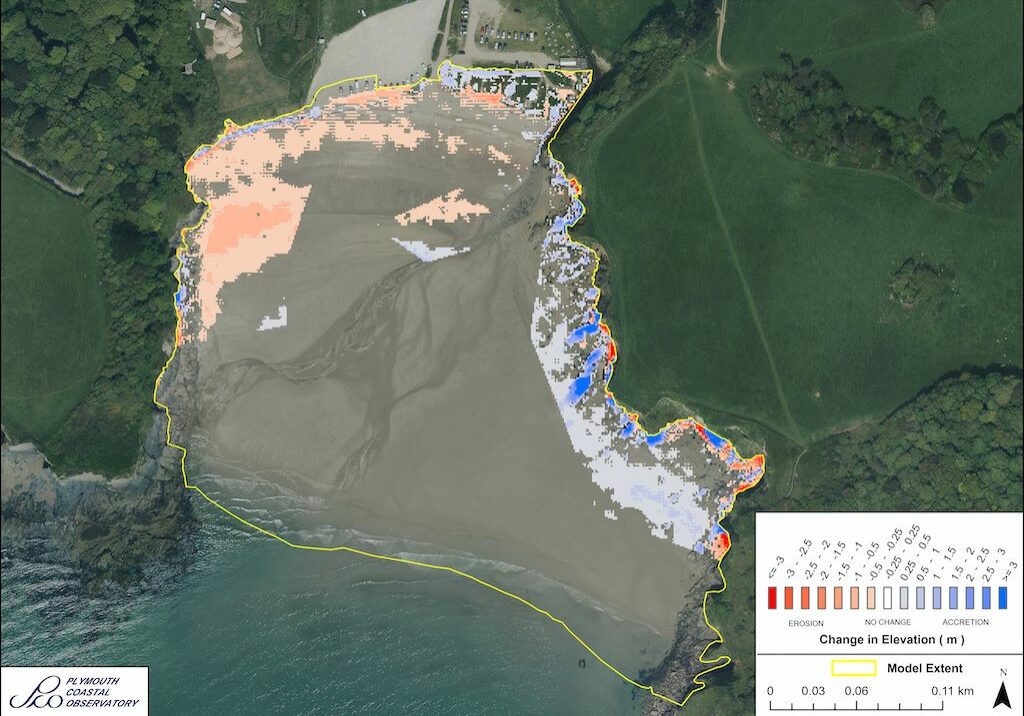
Porthluney Cove (Cornish: Porthlyvni, meaning ‘cove or landing place of the River Luney’) is a narrow south facing beach, within Veryan Bay, on the south coast of Cornwall. The Caerhays Stream flows onto the beach, channelled along its eastern edge after running down a deeply incised and undeveloped catchment.
Porthluney is a gently sloping beach with fine-medium grained sand, fringed by low, steep cliffs. The cove is considered a rural beach set against the backdrop of Caerhays Castle and the woodlands and parkland of the Estate. The uppershore of the beach is lined by a wall, constructed during the Second World War, and a small dunes system, behind which a carpark enables visitors to access the beach and the wider Estate.


Coastal Change
The coastline of Cornwall is an ever-changing environment. It is energetic, dynamic, never still and changes with each wave and each tidal cycle. Some of the changes we see are gradual and barely noticeable, whilst others, such as rockfalls, happen suddenly and often shockingly.
From one visit to the next it can sometimes be difficult to see how a beach and dune system has changed, but information has been collected, and is being collected through the Making Space for Sand project, to help us better understand how the coastline is changing. The purpose of this section of the website is to understand each location has changed over time, how it could change in the future and understand the policies that influence how we can respond to these changes.
Shoreline Management Plans (SMP)
The Shoreline Management Plan (SMP) is a strategic planning and management assessment tool that helps identify and measure the risk associated coastal erosion and coastal flooding. The document makes a number of policy recommendations over short, medium and long term timeframes setting out a strategic approach to managing the built, natural and historic environments associated with the coastline. Within SMP there are four policy approaches which have been assigned to stretches of coastlines. The four policies are: No Active Intervention (NAI), Hold the Line (HTL), Managed realignment (MR), and Advance the line (ATL).
Porthluney sits within Policy Development Zone 4 (PDZ4), in Management Area 9 (MA9), within Policy Unit (PU) 9.3. The policy recommendations for this policy unit are detailed in the table below and the SMP can be accessed through the Cornwall Council website.
Use your touchscreen
to scroll the below table
| Policy Unit | Policy Plan | ||||
| 2025 | 2055 | 2105 | Comment | ||
| 9.1 | Undefended cliffs & coves
Main Policy Sub Policy
|
NAI DnD |
NAI DnD |
NAI DnD |
Continue with NAI approach. Support AONB and Heritage Coast objectives. Allow natural coastal evolution to occur to support conservation interest of protected sites. |
| 9.3 | Caerhays Beach
Main Policy Sub Policy |
MR NF |
MR NF |
MR NF |
Allow the natural development of the sand dunes, thereby contributing to UK Biodiversity Action Plan targets, and reducing the visual impact of the car parks adjacent to the foreshore to the benefit of the Area of Outstanding Natural Beauty. Suitable management of the dunes may reduce the overall rates of erosion. This area is enclosed as registered park and garden. Some 'non-natural' defences are present.
|
| Key: HTL - Hold the Line, A - Advance the Line, NAI – No Active Intervention MR – Managed Realignment
Sub Policy: DnD – Do not Defend, PH – Place Holder, NF – Natural Features |
|||||


National Coastal Erosion Risk Mapping (NCERM)
National Coastal Erosion Risk Mapping (NCERM) provides a baseline of coastal erosion, for the coastline of England, over short, medium and long-term timeframes. The data is based on the natural and defence characteristics of the coastline and provides rates of erosion at differing levels of confidence to help better plan for worse case scenarios. The data provided is for guidance and does not estimate the absolute location of the future coastline.
The basic NCERM lines show erosion estimates for the Short Term (ST-20 years), Medium Term (MT-50 years) and Long Term (LT- 100 years). The data is further categorised by probability: 05 is 5% probability (a 1 in 20 chance of being exceeded) Red Shading, 50 is 50% probability of being exceeded (a 1 in 2 chance of being either exceeded or not exceeded) Orange Shading and 95 is 95% probability (a 19 in 20 chance of being exceeded) Yellow Shading. Click the link below to access the Cornwall Council NCERM Mapping site read the about section then click on layers.

Modelling Coastal Change

Using data that has already been collected, combined with data collected through the Making Space for Sand project, a series of models will be carried out at each location. This will help us better understand how each location may respond to sea level rise and gain a deeper understanding of how coastal sediments move and behave.
The complexity of the modelling, and the data collection that helps inform it, means that modelling outputs will not be the same on all sites. Some locations will be more thoroughly investigated to understand more complex issues and provide data that can be more widely applied to other sites with similar characteristics.
As the project develops this section of the website will expand, sharing new reports and coastal change projections when they are produced.
LiDAR surveys, which are explained on the Data Modelling page, have been carried out by the South West Coastal Monitoring program at this location. The image shared here visualises where sand has eroded (areas shaded in red) and where it has built up (areas shaded in blue), between the LiDAR surveys carried out in 1998 and 2019. The darker the shade of red or blue the greater the amount of sand erosion or accumulation has been observed. The image helps visualise that beaches are areas that change shape over time and will continue to do so as sea levels rise.


Designations
The coastline represents an important transition between the marine environment and the terrestrial environment. This transition creates a range of special habitats and exposes a range of interesting features, which that can result in these spaces being highly designated and protected. There are a range of designations that recognise a variety of different features. At this location these designations are explored below.
Site of Special Scientific Interest (SSSI)
A Site of Special Scientific Interest or SSSI is a statutory conservation designation notified by Natural England denoting protection for biological and/or geological characteristics. The natural wildlife and geological features of SSSI’s are considered to be irreplaceable parts of the national heritage. These are protected in order to preserve their importance, and to prevent damage and development.
The Cuckoo Rock to Turbot Point SSSI covers an area of 102.5 hectares. Cuckoo Rock to Turbot Point is a stretch of coastline around Veryan Bay in Cornwall which demonstrates superb exposures of a highly complex geological terrain. Its interpretation is fundamental to studies of the geological evolution of south-west England.
Image of an assortment of seaweed (Courtesy of Susan Scott)
Special Protected Area (SPA)
A Special Protection Area (SPA) are areas of international importance for the breeding, feeding, wintering and migration of rare, threatened or vulnerable bird species.
The Falmouth Bay to St Austell Bay SPA covers the area of 258,98 hectares, below mean high water (MHW),between Nare Point and Gribben Head. The area qualifies for designation as it is regularly used by Annex I listed species including the Black-throated diver, the Great northern diver and the Slavonian grebe.
Designated Cornwall National Landscape Area
From November 2023, all areas previously know as Areas of Outstanding Natural Beauty, or AONBs, were re-named National Landscape and in Cornwall became Cornwall National Landscape. However, the Management Plan still references the term AONB as this was formally adopted by Cornwall Council and cannot be amended until the next plan is produced.
National Landscapes are protected areas whose distinctive character and natural beauty are so outstanding that its in the nation’s interest to safeguard them. As such they have been nationally designated by the same legislation as National Parks and have the same status and level of protection.
Image of the Portscatho coastline (Courtesy of Annette Anderson)
The South Coast Central section of Cornwall National Landscape
The South Coast Central section of Cornwall National Landscape covers 15,993 hectares, which is 16.6% of the total Cornwall National Landscape area. The key landscape characteristics is a ridge which separates the Roseland from the Carrick Roads, consisting of a narrow strip of land barely half a kilometre wide between Zone Point and Gerrans Bay, broadens to include a stretch of varied and scenic coastland around Veryan Bay.
Image of Caerhays from the air
Sign up to Making Space for Sand
If you would like to get involved in helping to make dunes more resilient and biodiverse, want to help develop coastal adaptation and emergency plans or just want to know more about what the project is learning about coastal change, please click here:


